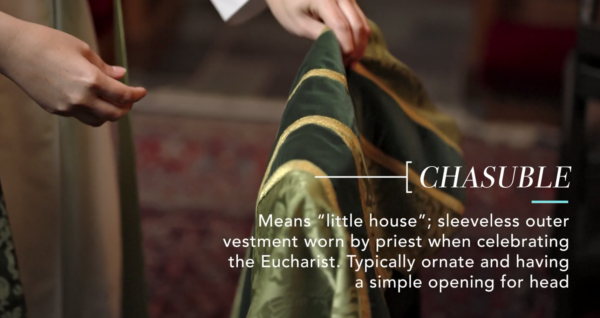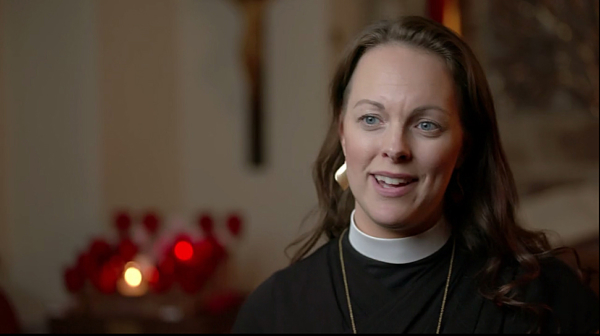How2charist offers digital version on typical ‘instructed Eucharist’Innovative project brought ‘ministerial entrepreneur’ into partnership with Church Center digital evangelism staffPosted Feb 21, 2019 |
|

The parts of the priest’s vestments are explained at the start of the How2charist. Photo: Screen grab/How2charist
[Episcopal News Service] If you run a traditional piece of Episcopal Church formation – the instructed Eucharist – through the new world of digital ministry, what do you get?
You get How2charist, an annotated video with a 28-page discussion guide for learning why Episcopalians do what they do when they celebrate the Eucharist. The on-screen explanations range from descriptions of the priest’s vestments and the vessels used on the altar to explanations of each part of the liturgy, such as the memorial acclamation and the epiclesis.
Many Episcopal priests occasionally preside at a Eucharist during which they stop the service to explain what they are doing and why, discussing tradition and liturgical theology. How2charist offers a seamless Eucharist that explains without stopping the action, so to speak.
The video can be viewed as a whole but is also available in individual chapters to make a four-session small-group series. Two of the sessions cover the flow of the Liturgy of the Word portion of the Eucharist through the Prayers of the People. The next two chapters show the Liturgy of the Table. The full film and the chapters can be viewed online or downloaded to use offline.
It’s all free for the taking. The only “charge” is an email address for getting a “token” that provides access to the film and discussion guide.
How2charist is the culmination of a nearly 11-year-old dream of the Rev. Callie Swanlund, an associate rector at St. Christopher’s Episcopal Church in Gladwyne, Pennsylvania. It also represents an innovative collaboration between Swanlund and The Episcopal Church’s digital evangelism team.

The Rev. Callie Swanlund has been dreaming about making How2charist since she was in seminary. Photo: Screen grab/How2charist’s trailer
The idea for How2charist came to Swanlund in 2008 when she took a course at Church Divinity School of the Pacific with the Rev. Micah Jackson called “New Media in Worship & Preaching.” Swanlund started with the idea of an instructed Eucharist and thought about VH1’s Pop-Up Video series, which between 1996 and 2006 added “pop-up” bubbles – called “info nuggets” – containing trivia, witticisms and other comments to music videos. Swanlund’s first version was a PowerPoint, but she and others kept thinking bigger.

In a screen grab from How2charist’s trailer, the Rev. Callie Swanlund breaks the host as an explanation appears on the screen.
How2charist has only been available since earlier this year, yet as of Feb. 20, the film has been viewed, at least in part, 1,310 times. Some 1,350 people have requested access codes to view it and the guide.
Feedback, both to Swanlund personally and via social media posts (which How2charist encourages), has shown her that the creative ways people are using How2charist go “beyond anything I could have dreamed up,” she said in a telephone interview with Episcopal News Service. Those ways include congregations using it to help train their acolytes and dioceses using it in their classes for training would-be priests locally.
One congregation plans to “deconstruct” the video, adding some of the pop-up explanations to the printed special bulletins they use to guide guests who come to witness baptisms. “It goes back to, in some ways, what I was moving away from in making this digital version, but I love it,” she said. “It shows that they love the information contained in it and not just some flashy model of presentation.”

The film crew, led by Michael Collins, Episcopal Church manager of multimedia services, left, discusses its plan as the Rev. Callie Swanlund stands at the altar and the Rev. Nancy Frausto, a priest in the Diocese of Los Angeles, listens at right. How2charist was staged at Trinity Episcopal Church in Ambler, Pennsylvania. The full-length Spanish version, in which Frausto presides at Church of the Epiphany in Los Angeles, is due out this spring. Photo: Jeremy Tackett
The choice of liturgical style was a challenge. “That was the fear that kept me awake,” Swanlund said. Though, she knew she had a good film crew and a good group of volunteers both on screen and behind the scenes as consultants to prevent her from doing something “that is going to get me burned at the stake.” She also knew that “it’s me that it falls on” because she was claiming to be “representing the Eucharist to the entire Episcopal Church.”
Swanlund anticipated valid criticism. She also figured there might be some nitpickers “because we’re Episcopalians and we love to be nitpicky; I think it is one of our core values,” she said, laughing. Such criticism “comes from a place of deep love and care for our liturgy,” Swanlund said.
Swanlund aimed for what might be called “a broad church” liturgical style, not too plain or “low church” and not too much of the so-called “smells and bells” associated with a “high-church” style of presiding. She encouraged the volunteer congregation to act the way they would in their own churches. So, some people crossed themselves frequently; others did not. Some sang and prayed with raised hands. Some knelt when others stood.
“I wanted to honor this liturgy that we share. It’s common prayer, so I wanted to make it as common as possible, knowing that there are differences,” she said. The discussion guide gives viewers the chance to reflect on the differences they see.
Criticism “has been, so far, less than I anticipated,” but there has been some, she said. Very few people said that they wished the style had been lower, but some wished it had been higher, Swanlund said. And, then, there was the debate on the online discussion site Reddit about whether her left-handedness invalidated her blessings.

Some viewers debated whether it was appropriate for the Rev. Callie Swanlund to bless with her left hand. Photo: Screen grab/How2charist
There are overhead shots, close-up shots, multiple angles and slow-motion sequences. “We wanted to have the people watching it to have an intimate view of the Eucharist that they might never have in a typical Sunday service,” she said. A project with these kind of production values costs money.
Swanlund started an online fundraising effort through Kickstarter to pay for How2charist. The effort began during General Convention’s meeting in Austin, Texas, last July.
The Diocese of Texas was an early backer, according to Swanlund. Carol Barnwell, who was then the diocesan director of communication, “was a cheerleader,” even during an earlier effort when Swanlund realized she was not in a position at that time to pull it off. Diocese of Los Angeles Bishop Suffragan Diane Jardine Bruce took Swanlund to meet other bishops in Austin. The diocese became How2charist’s largest backer. Swanlund also contacted other bishops she knew.
There were non-Episcopalians who became supporters, some at the $500-or-more partner level, such as Jenn Giles Kemper, the developer of the Sacred Ordinary Days planner. Giles Kemper is what Swanlund called a “liturgical Baptist” from Waco, Texas. “To see another woman entrepreneur say, ‘I’m committed to this project and also to other women doing ministerial entrepreneurship’ was really, really cool,” Swanlund said. “It buoyed me.”
The support of 236 Kickstarter backers, including dioceses, congregations and individuals, raised $35,000. Swanlund said many backers whom she did not know have since introduced themselves to her at events, and they seem to express “a communal pride” about being part of the project.

The film crew shot from many angles during the Eucharist at Trinity Episcopal Church in Ambler, Pennsylvania. Photo: Jeremy Tackett
How2charist also fits with the mandate that General Convention gave the churchwide staff in 2015 (via Resolution 2015_B009) to create somewhat timeless content that would be available to the church for download. Jeremy Tackett, the church’s digital evangelist and senior manager for creative services, told ENS that “rather than simply try to figure out on our own what kind of content would be attractive to the church, we decided to look for creators who were already in the process of doing unique things in the church.”
He called Swanlund’s Kickstarter effort “innovative” and explained that “if the fundraising was successful on its own, we knew that we’d have a project with buy-in from folks who would use it once created.” Its success gave the Digital Evangelism department “an established proof of concept” that showed that the church’s partnership with Swanlund would be “good stewardship of our resources,” Tackett said.
Swanlund’s fund covered the costs of developing and filming the English language version of the How2charist. Tackett’s department took the project through post-production, including producing a Spanish-language version, and into distribution of the film and guide. (The full-length Spanish video, in which the Rev. Nancy Frausto presides at Church of the Epiphany in Los Angeles, is due out this spring.)
Tackett said he is excited about using the model of How2charist in future projects. “By partnering with creators throughout the church, we’re able to expand the pool of ideas and concepts beyond what those connected directly to our office can conceptualize,” he said. “And by working with creators who have a model for at least ‘seed’ fundraising, we can establish that there’s an audience and market for the product we’re helping bring to life.”
The hope, he said, is that both his office and Swanlund can now become “partners with and guides to other dreamers who are doing unique things in the world of digital ministry, and that we can bring those ideas to a churchwide audience.”
– The Rev. Mary Frances Schjonberg is the Episcopal News Service’s senior editor and reporter.

Social Menu